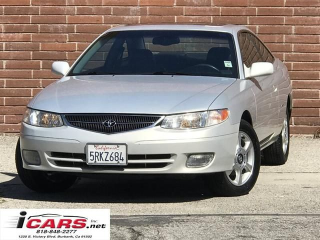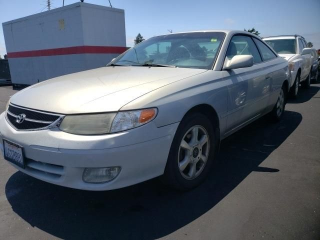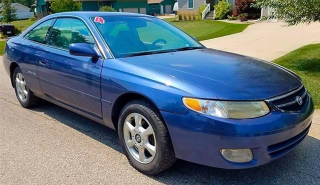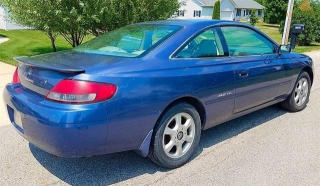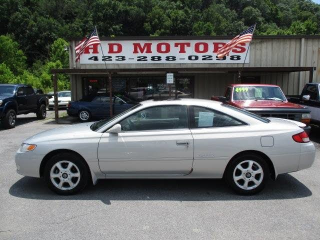The Good
The 1999 Toyota Camry's advantages are numerous. Its legendary reliability offers unparalleled peace of mind for practical buyers, while its comfortable, quiet ride and spacious interior appeal to those seeking a relaxed daily commute. Excellent fuel efficiency minimizes running costs, and its strong resale value makes it a smart financial decision. It represents a sensible, long-term investment, balancing practicality with understated appeal.
The Bad
While highly reliable, the 1999 Toyota Camry has weaknesses to watch for. Some V6 engines were susceptible to oil sludge issues if maintenance was neglected, potentially leading to costly repairs. Aging components like suspension bushings, power steering pumps, and exhaust systems can require attention. Rust can be a factor in older models from salt-prone regions.
1999 Toyota Camry: Quick Overview
The 1999 Toyota Camry offered a choice of two robust engine options and varied trim levels.
- Engine Options:
- 2.2-liter 5S-FE inline four-cylinder engine.
- 3.0-liter 1MZ-FE V6 engine.
- Horsepower:
- The four-cylinder produced 133 horsepower and 147 lb-ft of torque.
- The V6 offered a more potent 194 horsepower and 209 lb-ft of torque.
- Fuel Economy (EPA Estimates):
- 2.2L I4 (automatic): Approximately 20-23 MPG city / 28-30 MPG highway.
- 3.0L V6 (automatic): Approximately 18-20 MPG city / 26-28 MPG highway.
- 0-60 MPH Times:
- 2.2L I4: Around 9.5 to 10.5 seconds.
- 3.0L V6: Around 7.5 to 8.5 seconds, providing brisker acceleration.
- Towing Capacity: Typically rated for up to 1,000 pounds, suitable for very light utility trailers.
- Trim-Level Features:
- CE (Base): Focused on affordability, often included basic amenities like manual windows and door locks (power options available), AM/FM stereo, air conditioning, and 14-inch steel wheels. It provided essential transportation without frills.
- LE (Mid-Range): Stepped up with standard power windows, power door locks, cruise control, body-colored side mirrors, and intermittent wipers. It often featured upgraded cloth upholstery and 15-inch steel wheels with wheel covers. Optional ABS was commonly found on LE models.
- XLE (Luxury): The top-tier trim boasted a more refined experience with automatic climate control, woodgrain interior accents, a premium audio system (often with CD player), remote keyless entry, a power-adjustable driver's seat, and 15-inch alloy wheels. Leather seating was an often-selected option, enhancing its upscale appeal.
1999 Toyota Camry Specifications
Vehicle Information
| Year | 1999 |
| Make | Toyota |
| Model | Camry |
| Trim | - |
| Style | - |
| Type | Sedan |
| Category | Compact Car |
Manufacturing Details
| Made In | Japan |
| Manufacturing City | TOYOTA CITY |
Dimensions
| Doors | 4-Door |
| Curb Weight | - |
| Gross Vehicle Weight Rating | - |
| Overall Height | - |
| Overall Length | - |
| Overall Width | - |
| Wheelbase Length | - |
| Standard Seating | - |
Engine & Performance
| Engine | 5S-FE |
| Engine Size | 3L |
| Engine Cylinders | 20202 |
| Transmission | - |
| Transmission Type | - |
| Transmission Speeds | - |
| Drivetrain | Rear-Wheel Drive |
Additional Features
| Anti-Brake System | - |
| Steering Type | - |
Pricing
| Manufacturer Suggested Retail Price (MSRP) | - |
| Invoice Price | - |
| Delivery Charges | - |
Vehicle History Report
Specifications
History
Events
History Check
Check
Check
Check
Check
Listings
Recalls
Check
Analysis
What Problems Does the 1999 Toyota Camry Have?
The most significant and widely documented issue, particularly for the 1999 V6 models equipped with the 3.0-liter 1MZ-FE engine, is the susceptibility to oil sludge buildup. This problem, prevalent across certain 1997-2002 Toyota V6 engines, could occur if owners neglected frequent oil changes, leading to restricted oil passages and potential engine damage. Toyota did acknowledge the issue and offered extended warranties or assistance for some owners, but it remains a critical point of inspection for any used V6 Camry from this era. Regular, diligent oil changes are paramount to preventing this.
Other common issues reported by owners of the 1999 Camry include:
- Power Steering Leaks: Hoses, pumps, or the steering rack itself are prone to developing leaks over time, requiring fluid top-offs or component replacement.
- Oxygen Sensor Failures: As with many older vehicles, O2 sensors wear out, triggering 'Check Engine' lights and potentially affecting fuel economy.
- Catalytic Converter Issues: Age and mileage can lead to inefficient or failed catalytic converters, another potential source of 'Check Engine' lights.
- Ignition Coil Malfunctions: These can cause engine misfires, leading to rough idling or reduced performance.
- Window Regulator Failures: Power window motors and regulators can fail, preventing windows from operating correctly.
- Suspension Component Wear: Worn struts, control arm bushings, and tie rod ends are common, leading to clunking noises, reduced ride comfort, or poor handling.
- Rust: In regions where road salt is used, rust can be a significant issue, affecting subframes, rocker panels, and wheel wells.
Long-term reliability concerns are generally limited to these specific points and standard age-related wear. A well-maintained 1999 Camry, especially the I4 version, can still be remarkably reliable.
How long will the 1999 Toyota Camry last?
However, even with outstanding durability, weaknesses emerge over time. Beyond the specific V6 oil sludge concern, general age-related wear includes degradation of rubber components like suspension bushings and engine mounts, leading to increased noise or reduced ride comfort. Power steering leaks become more common, as do minor electrical issues such as failing window regulators or flickering dashboard lights. Rust in high-salt regions is also an inevitable adversary. Despite these, the core mechanicals generally hold up exceptionally well, solidifying its reputation as a "million-mile car" with proper care.
What Technology & Safety Features are Included?
Built-in Tech and Entertainment:
Standard entertainment typically consisted of an AM/FM cassette stereo, with higher trims or optional packages often including a single-disc CD player. Climate control was manual on the CE and LE trims, while the XLE offered a more sophisticated automatic climate control system. Power windows, power door locks, and cruise control were standard on LE and XLE models, and optional on the base CE. Remote keyless entry was a convenient feature, standard on the XLE and available on the LE. There were no advanced infotainment screens or smartphone integration capabilities commonly found in contemporary vehicles.
Driver-Assistance Features:
Modern driver-assistance technologies like blind-spot monitoring, lane-keeping assist, or adaptive cruise control were non-existent in the 1999 Camry. The primary "driver assistance" came in the form of power steering and, optionally, anti-lock brakes.
Safety Features:
Safety was addressed with standard dual front airbags for both the driver and front passenger. Anti-lock Braking System (ABS) was an important optional safety feature, commonly found on LE and XLE trims, providing enhanced control during emergency braking. All outboard seating positions featured three-point seatbelts, and the vehicle included child safety seat tether anchors. Side-impact door beams were integrated into the design to help protect occupants in a collision.
Crash-Test Ratings:
The 1999 Camry performed reasonably well in crash tests for its time:
- NHTSA (National Highway Traffic Safety Administration):
- Frontal Crash Test (Driver): 4 out of 5 stars
- Frontal Crash Test (Passenger): 4 out of 5 stars
- Side Crash Test (Front Seat): 3 out of 5 stars
- Side Crash Test (Rear Seat): 3 out of 5 stars
- IIHS (Insurance Institute for Highway Safety):
- Moderate Overlap Frontal Test: It received a "Good" rating, which was commendable for vehicles in its class during that period.
What Colors Options are Available?
1999 Toyota Camry Prices and Market Value
Today, the 1999 Camry has long passed its major depreciation phase. Current used market prices are highly dependent on the vehicle's condition, mileage, and maintenance history. You can find examples ranging from as low as $1,500 for a "beater" with high mileage and cosmetic flaws, to over $5,000 for exceptionally well-preserved, low-mileage specimens. Most decent, running examples typically trade hands between $2,500 and $4,000.
Factors significantly affecting current resale value include the absence of rust, a clean interior, verifiable maintenance records (especially critical for V6 models to show oil sludge prevention), and lower odometer readings. The I4 engine can sometimes fetch a slightly higher premium among informed buyers due to the V6's oil sludge reputation. Its enduring reputation for reliability ensures it maintains a strong "utility value" in the affordable used car market.
1999 Toyota Camry Cost of Ownership
Maintenance and repair costs are among the lowest in the industry. Parts are abundant, inexpensive, and nearly every mechanic is familiar with servicing these vehicles. Many routine tasks are also DIY-friendly. While significant issues like V6 oil sludge can lead to costly engine repairs if neglected, the majority of repairs are minor and affordable. Its robust design, coupled with low depreciation, makes the 1999 Camry one of the most budget-friendly cars to run and maintain for extended periods, representing outstanding value for money.
1999 Toyota Camry Fuel Efficiency
1999 Toyota Camry Safety Rating
NHTSA
1999 Toyota Camry Insurance
reasonable repair costs.
How Does the 1999 Toyota Camry Compare to Other Sedan?
In terms of performance, the Camry, particularly with its V6 engine, offered respectable acceleration and a very smooth, composed ride. However, it wasn't known for being a "driver's car." The Honda Accord of the same generation often had a slight edge in driving dynamics, feeling a bit more agile and engaging. The Nissan Altima also aimed for a sportier feel but wasn't always as refined. The Ford Taurus and Chevrolet Malibu generally offered less inspiring performance and handling.
Regarding features, all these vehicles offered similar amenities across their trim levels, including power accessories, cruise control, and air conditioning. The Camry XLE and Accord EX often stood out for their more upscale interiors and available options like leather seating and automatic climate control.
Reliability is where the Camry truly shined, often considered the gold standard. The Honda Accord was a very close second, also renowned for its dependability. The Nissan Altima saw improvements in reliability during this generation but generally didn't quite match the Camry or Accord's bulletproof reputation. The Ford Taurus and Chevrolet Malibu, while offering competitive pricing new, often suffered from more frequent and sometimes costlier repairs, significantly trailing the Japanese rivals in long-term reliability.
Price in the current used market reflects these reliability differences. The 1999 Toyota Camry and Honda Accord tend to hold their value better and command a slight premium due to their enduring reputations. The Nissan Altima, Ford Taurus, and Chevrolet Malibu are typically found at lower price points, but buyers must weigh the initial savings against potentially higher future maintenance and repair expenses.
Similar or Better Alternatives: If you're considering a 1999 Camry, the 1998-2002 Honda Accord is a direct and equally compelling alternative. It offers comparable reliability, excellent fuel economy, and often a more engaging driving experience. For those on a tighter budget, a Nissan Altima could be an option, but rigorous inspection and a clear maintenance history are even more crucial. Avoid the domestic rivals if reliability and low long-term ownership costs are your top priorities.
Final Verdict: Is the 1999 Toyota Camry a Good Sedan?
Is it worth buying today? Absolutely, but only under specific conditions as a used vehicle. A thorough pre-purchase inspection by a trusted mechanic is non-negotiable, focusing on potential rust, common aging components, and crucially, evidence of diligent oil changes, particularly if considering the V6 engine to mitigate oil sludge risks. The four-cylinder engine generally offers a safer bet for long-term reliability.
Look for well-maintained LE or XLE trims, as they offer a better balance of comfort features without significantly increasing complexity. Avoid examples with significant rust or neglected maintenance. It's not for those seeking spirited performance, cutting-edge technology, or luxury, but for sheer enduring value and peace of mind, a well-cared-for 1999 Camry remains an outstanding "appliance car" purchase.
